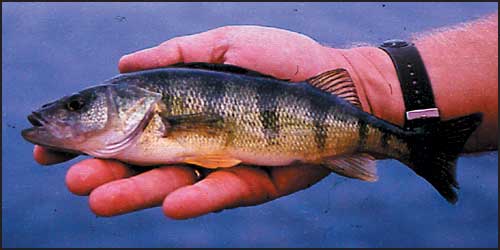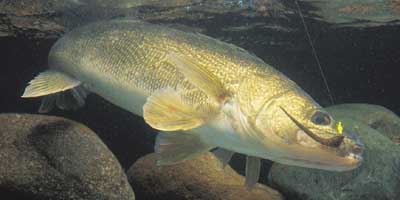
Quick Tips:
Pike snap at anything that
will fit into their jaws, and even a few things that won't. More
often, pike
seem off their feed and nothing is tempting enough. Presentation
is the key in such a situation. For
finicky pike, experiment with lure speed and action. An erratic,
stop-and-start retrieve along the
surface with a large, floating, minnow imitation, for example,
will often draw a strike.
Although pike don't 'school,'
in the typical sense, it is very common for pike to congregate
in an
area with members of their own year-class. If you catch a good
pike, don't assume it's a lone wolf
and leave the area. It's just as likely there are other big fish
near by.
When the pike are visible
but just won't bite, try dropping a neutral-buoyancy jig or plug
in front of it
and then doing nothing. The natural defence of many forage species
is to freeze until trouble
passes. A pike made wary by watching hundreds of retrieves can
be tricked by making him watch a
sitting duck.

Quick Tips:
Tipping
a small jig or spinner with a worm can increase your chances of
catching light-biting perch
on those off days when the fishing is slow.
Yellow
perch are attracted to bright colours (like red and yellow). Try
adding several strands of bright
coloured yarn or thread to the shank of your hook or jig. If you
anchor a lot, try adding coloured
plastic flags to your anchor rope and you'll see how more productive
your fishing can be.
When
using live minnows for perch, make sure they are tiny (no more
than two inches long). Many
anglers use larger minnows and never have more than a few hits
a day.

Quick Tips:
Walleye
are notorious 'short hitters' and will sometimes fail to strike
with sufficient determination to
become hooked. When this occurs, try rigging a baited trailer
hook to your spoon to draw a more
vigorous response from the fish. A small treble works best.
If
you are jigging near heavy weeds and find yourself constantly
struggling with weeds on your jig,
try snapping your jig off bottom. This will help you rip through
vegetation and, at the same time,
your jig will drop in front of fish in a more natural way. The
best type of artificial jigs to use for this
are Shad type jigs like Berkley's Shimmy Shad (pearl) and hair
jigs in (black).
On
heavily fished lakes, walleyes can become used to constant trolling
pressure. Try using planer
boards with Rapalas and worm harness type rigs in areas that everyone
is fishing. You may be
pleasantly surprised with the results.

Quick Tips:
<b>Rainbow Trout:</b> One of the most versatile lures for small-stream fishing is the spinner.
Spinners can be cast upstream and allowed to tumble along with the current or they can be cast
across the current so that they swerve across pools and runs in a slower and more enticing fashion.
Spinners are so handy to cast that they become an ideal lure for 'pinpoint' tosses to rocks, logs,
undercut banks, or other likely structures.<b>Steelhead:</b> When fishing with spawn bags, always try to use the appropriate size and
colour, based on water clarity. Use bright, large bags in dirty water. In clear water, pale-coloured,
single eggs are often drifted on light lines.Spinners, too, should be chosen according to water visibility. A silver Blue Fox, Vibrax No. 4 or
Mepps Aglia would be a good choice for a flooded river, while a black No. 1 or 2 Aglia would be
perfect for crystal-clear waters.Steelies will hit wet flies such as the Michigan Wiggler or the stonefly nymph. These are especially
effective when they're drifted through riffles below a pencil float or a strike indicator.